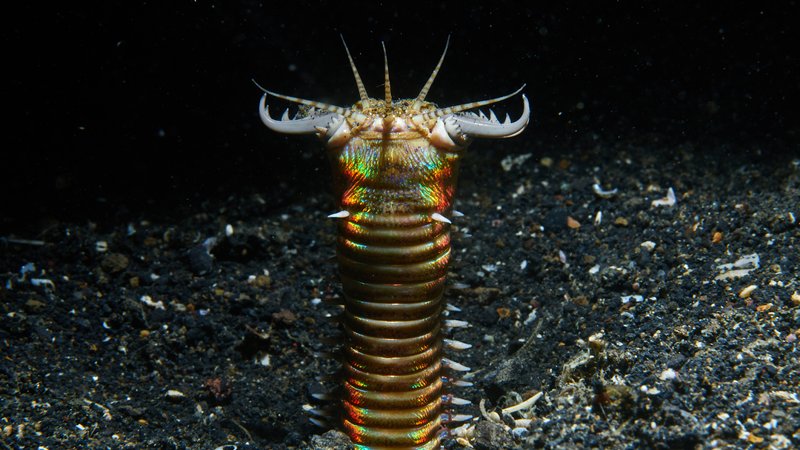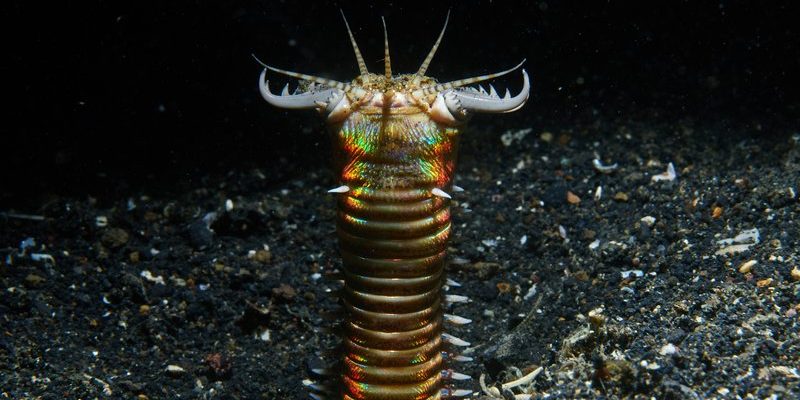
Bobbit worms, particularly the species *Eunice aphroditois*, can grow up to ten feet long and are well known for their striking colors and powerful jaws. If you’re a beginner wanting to learn about these intriguing creatures and their role in the sandbed ecosystem, you’ve come to the right place. We’ll break down their behavior, habitat, and how they interact with other species. So grab your favorite coffee, and let’s dive in!
What Are Bobbit Worms?
Bobbit worms are large, predatory marine worms found in tropical and subtropical oceans. They belong to the class Polychaeta, which means “many bristles”—a nod to their bristly appearance. These worms live buried in the sand, with only their colorful heads and long, segmented bodies visible.
Their bodies are equipped with sharp jaws that can snap shut quickly, making them surprisingly effective hunters. Picture a snake striking its prey. That’s how Bobbit worms operate! They feast on fish, crustaceans, and other small marine animals that wander too close to their hidden burrows. When a meal is sensed, they strike with lightning speed, dragging their prey into the sand.
What’s fascinating is that Bobbit worms can regenerate lost segments of their bodies, which makes them resilient and adaptable. This ability not only helps them survive predation but also plays a role in their ecological niche.
The Sandbed Ecosystem: A Hidden World
The sandbed ecosystem is essentially a bustling underwater city that often goes unnoticed. This ecosystem includes various organisms, like microbes, crustaceans, mollusks, and, of course, Bobbit worms. Each player plays a vital role, contributing to the overall health and balance of the environment.
Sandbeds serve as crucial habitats for many marine life forms. They provide food, shelter, and breeding grounds. Just like how a forest floor is rich with plants and insects, the sandbed is teeming with life that relies on the intricate relationships among its inhabitants.
Bobbit worms, through their predation, help regulate populations of smaller creatures, ensuring that no single species dominates. This balance is essential for keeping the ecosystem healthy. Without such dynamics, you could end up with a sandbed overrun by one species, which could lead to a collapse of the ecosystem.
Bobbit Worms’ Role in the Sandbed Ecosystem
Bobbit worms occupy a unique niche in the sandbed ecosystem. As predators, they help control the populations of various smaller animals, preventing overpopulation. This keeps the ecosystem stable and diverse, allowing for a variety of species to thrive.
These worms are also scavengers. When prey items die, Bobbit worms help break down and recycle organic material back into the ecosystem. They contribute to nutrient cycling, which is essential for supporting plant life and microorganisms. You can think of them as nature’s recyclers, breaking down what others leave behind.
Moreover, their burrowing behavior aerates the sand, allowing water to circulate better. This process helps maintain healthy conditions for other organisms living in the sandbed, such as beneficial bacteria and algae. A well-aerated sandbed is crucial for maintaining balance and ensuring that all inhabitants can thrive.
Interactions with Other Marine Species
Bobbit worms are not loners; they interact with various species in their ecosystem. For instance, they may compete with other predators, such as larger fish or crustaceans, for food. This competition, while it may seem fierce, is part of a healthy dynamic that keeps populations in check.
Additionally, they serve as prey for larger marine animals like fish and sea turtles. So, while they are fierce hunters, they also become targets themselves. This dual role emphasizes the interconnectedness of the sandbed ecosystem. If Bobbit worms were to disappear, it would create ripple effects, affecting both their prey and the predators that rely on them for food.
Interestingly, some marine animals may even use the burrows created by Bobbit worms for shelter. These interactions illustrate the complexity of the ecosystem, showing that every creature has a role, no matter how small or seemingly insignificant.
Threats to Bobbit Worms and Their Habitat
Despite their resilience, Bobbit worms face several threats in their marine environments. Habitat destruction, largely due to human activities like coastal development and pollution, poses a significant risk. When sediment is disturbed, it can damage the delicate ecosystem that Bobbit worms depend on.
Additionally, climate change impacts the oceanic conditions where Bobbit worms live. Changes in water temperature and acidity can affect their reproductive cycles and survival rates. As the ocean becomes warmer and more acidic, the balance of the sandbed ecosystem shifts, causing stress on many species.
Overfishing and the introduction of invasive species also threaten Bobbit worms. When their natural predators are removed or when new species outcompete them, the stability of the ecosystem becomes compromised. Protecting Bobbit worms means not only safeguarding their species but also the intricate web of life they support.
How to Protect Bobbit Worms and Their Ecosystem
Protecting Bobbit worms and the sandbed ecosystem requires collective action and awareness. Here are some steps we can take:
- Support Sustainable Fishing: Choose seafood that is sustainably sourced to help maintain balanced predator-prey relationships in the ocean.
- Reduce Pollution: Participate in clean-up efforts and reduce plastic use to prevent harm to marine environments.
- Promote Marine Protected Areas: Advocate for the establishment of marine protected areas to preserve essential habitats.
- Educate Others: Sharing information about Bobbit worms and their roles in the ecosystem can raise awareness and promote conservation efforts.
By taking these actions, we can help ensure that Bobbit worms and the rich ecosystems they inhabit are preserved for future generations.
Bobbit worms may seem like just another oddity of the ocean, but their role in the sandbed ecosystem is vital. They maintain balance, recycle nutrients, and interact beautifully with countless marine species. Understanding their complexity can deepen our appreciation for the ocean’s incredible biodiversity.
As we continue to explore and learn about these fascinating creatures, let’s also remember the importance of protecting their habitats. After all, every creature, big or small, plays a part in the intricate web of life beneath the waves. So next time you think about the ocean, consider the Bobbit worm and the hidden dynamics of the sandbed ecosystem. It’s a world worth protecting!

